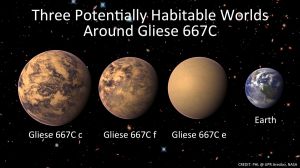
Gliese 667C and its three habitable worlds.
http://www.space.com/21708-images-habitable-alien-planets-gliese-667c.html
There are six very specific biological requirements for life. These biological requirements apply to all life on Earth. In looking for extraterrestrial life scientists must establish a set of conditions that would make a planet or other celestial object habitable. There are many unknowns regarding possible conditions of habitable worlds because scientists can only study life on Earth and the specific conditions it has evolved in. Life that has not been discovered could exist in conditions previously thought to be uninhabitable.
When looking for life scientists first look for habitable worlds leading them to generally focus on exoplanets or planets outside our solar system. Why do scientists favor exoplanets? Could life exist on asteroids or moons of exoplanets? Life could exist on moons, in fact Jupiter’s moon Europa and Saturn’s moon Titan may harbor microbial life deep under their frozen surfaces. But moons simply are not an astrobiologist’s first priority because locating a small moon is unfeasible. It is much easier to find and then study much larger exoplanets.
Asteroids are also very difficult to locate because of their small size and their variable orbits. This does not completely undermine the possibility that life may exist on or in an asteroid. Life requires consistent conditions to survive. Due to the variability of their orbits, asteroids ’exposures to solar radiation and asteroids’ temperatures randomly fluctuate. This compounds the fact that asteroids lack atmospheres to protect life from solar radiation and to maintain a habitable climate.
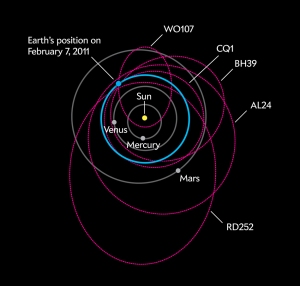
Variable orbits of asteroids in our solar system.
http://www.scientificamerican.com/article.cfm?id=graphic-science
Unlike asteroids, exoplanets have steady orbits these steady orbits create stable conditions that allow life a chance to develop and thrive. A consistent orbit does not ensure life, as the lack of life on all planets in our solar system, besides Earth, illustrates. Planets must orbit at a specific distance from a star; not too far and not too close. If the radius of an orbit is small, signifying the planet orbits the star closely it will be too hot on the planet for liquid water to form.
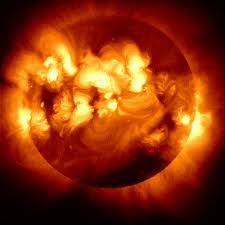
Solar radiation.
http://www.wired.com/dangerroom/2008/04/this-one-goes-t/
Also, great amounts of solar radiation will bombard the planet damaging any life that exists even in the absence of liquid water. If the radius of an orbit is very large, meaning the planet orbits very far away from the star, it will be too cold to harbor any life. These low temperatures are caused by a lack of solar radiation to heat the planet up. “Too close” and “too far” are relative terms that depend on the type of star a planet orbits. Inevitably, every solar system has a “too close” and a “too far”, but these distances vary depending on the type of star being orbited.
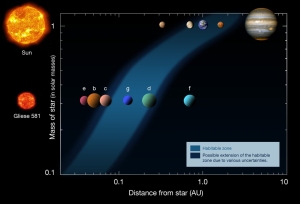
Habitable zone of our solar system is highlight in blue.
http://en.wikipedia.org/wiki/Circumstellar_habitable_zone
A “just right’ orbital radii do exist and scientists call this range of “just right” the habitable zone. In the habitable zone, planets receive just the right amount of solar radiation to produce temperatures conducive to the formation of liquid water. Being in this zone, is the first characteristic of an exoplanet that an astrobiologist’s note when looking for habitable worlds.
The second characteristic, astrobiologists consider is atmosphere. An atmosphere must be composed of water vapor, because all known life requires water and the ample protection water vapor provides from solar radiation (any Greenhouse Gas will provide ample protection). It is possible for life to exist in atmospheres composed primarily of other substances such as carbon dioxide. Earth’s early atmosphere consisted of mostly carbon dioxide. Finding an atmosphere composed primarily of water vapor is a bonus because finding an atmosphere any significance is highly unlikely in and of itself. To determine the composition of an atmosphere scientists study the Rayleigh Effect. This is the change of wavelength of light once it strikes any medium. In a low hanging atmosphere composed of water vapor, the Rayleigh Effect is significantly weaker than in a high hydrogen based atmosphere because a lot of light misses the low hanging one entirely.
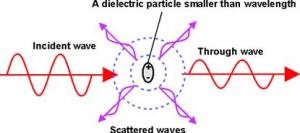
The Rayleigh Effect.
http://www.invocom.et.put.poznan.pl/~invocom/C/P1-9/swiatlowody_en/p1-1_2_2.htm
Recently scientists observed this phenomenon on the planet Gliese 1214b , which orbits the low mass star, Gliese 667C. The discovery of an exoplanet in a habitable zone is very unlikely. So the discovery of an exoplanet in the habitable zone that has a water rich atmosphere carries incredible significance. Its very discovery means that there are probably other exoplanets like it elsewhere (statistically very likely because the Milky Way is 80% low mass stars) and more importantly it means there could be life on Gliese 1214b.
Sources
“A SuperEarth With a Water-Rich Atmosphere.” Astrobiology Magazine. Helen Matsos, 6 Sept. 2013. Web. 30 Sept. 2013. <http://www.astrobio.net/pressrelease/5665/a-superearth-with-a-water-rich-atmosphere>.
“One Star, Three Habitable Planets.” Astrobiology Magazine. Helen Matsos, 26 June 2013. Web. 30 Sept. 2013. <http://www.astrobio.net/pressrelease/5533/one-star-three-habitable-planets>.
